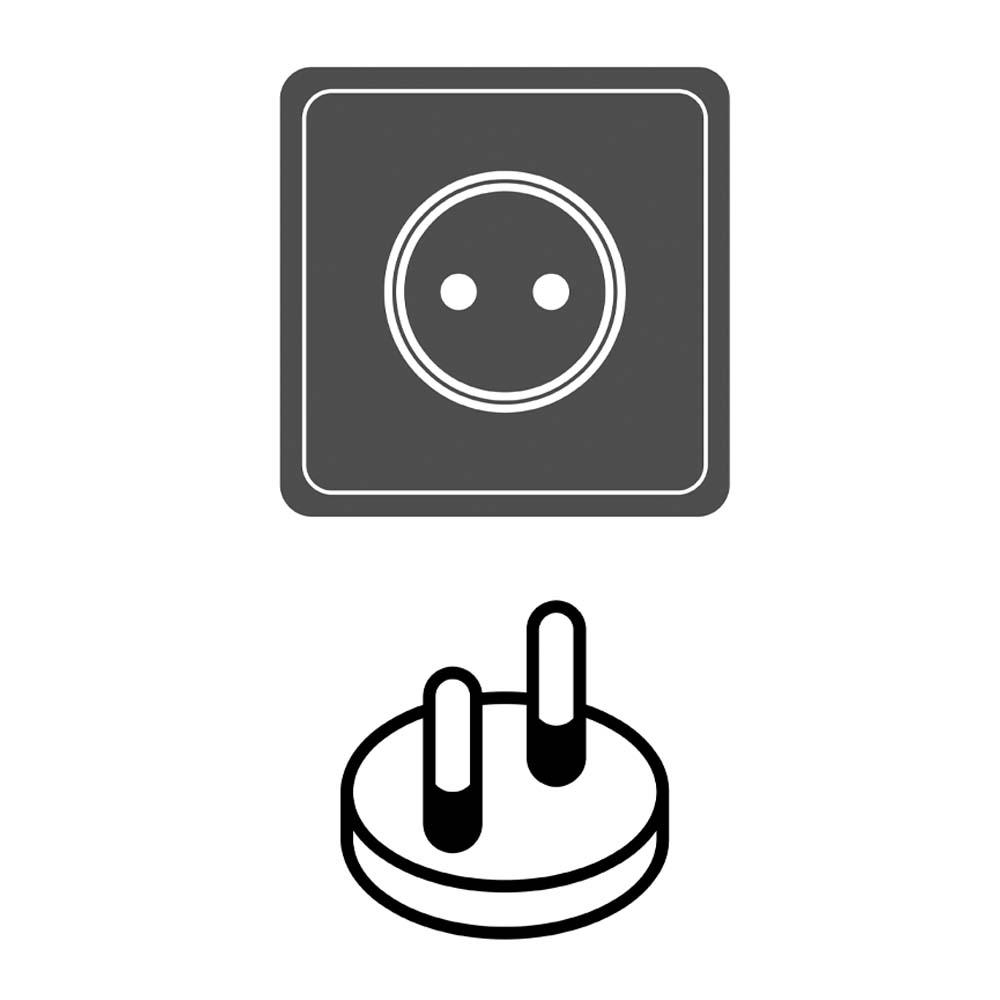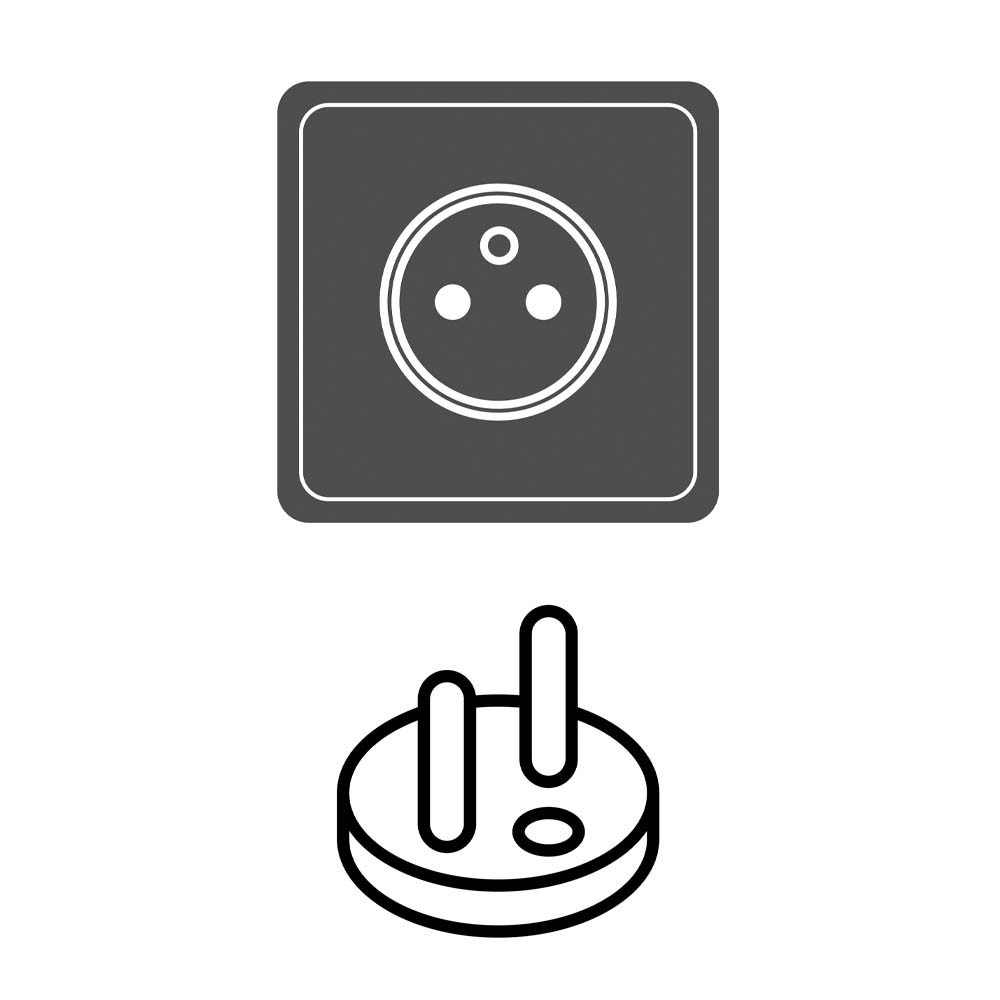Country Snapshot: Electrical Overview
Electric Current
Electricity is supplied in France at 230 volts AC, 50 Hertz (Hz).
Electric Plug
Electric plugs in France are of two types: “Type C” Europlug CEE 7/16 and “Type E” CEE 7/6.
The Type C plug is known as the Europlug and is the most universally-used plug in the world, largely because it can be used with a number of different sockets. In addition to France, it is used in most continental European countries, some Middle Eastern countries, and many African, South American, and Asian countries. It is a narrow-headed plug with two round pins spaced horizontally from each other, with no grounding pin. See the illustration at right. Type C plugs are generally limited to devices and appliances that require 2.5 amps or less.
The Type E plug is a round-headed plug. Like the Type C plug it has two round pins spaced horizontally from each other. Unlike the Type C plug, however, the Type E also has a circular hole above its pins to accept a grounding pin that protrudes from a wall socket. See the illustration at right. In addition to France, the Type E plug is used primarily in Belgium, Czech Republic, Poland, Slovakia, Tunisia, Morocco, and a number of African countries.
Note that most modern Type F plugs, called “Schuko” plugs, will also work in France's outlets. Traditionally, Schuko plugs did not have the circular hole above the pins to accept the Type E wall socket’s grounding pin. Most modern Schuko plugs do have this hole, and if your device has such a plug then it should work in France.
Electric Plug Adapter
If your electronic device or appliance does not use a Type C, Type E, or Schuko plug, you may need an electric plug adapter. Plug adapters are available both online and in stores from travel companies, drugstores, and big-box stores. Note that an adapter allows a foreign device to plug into a French outlet, but it does not change the electric voltage coming out of the outlet.
Using Home-country Appliances and Devices in France
The feasibility of using home-country electrical appliances and electronic devices in France depends on a number of factors, including the type of appliance or device and the voltage on which it operates.
Electrical Appliances
Electrical appliances are high-wattage items that use a mechanical motor or heating element (e.g., hair dryers, curling irons). If an appliance operates at 220–240 volts, 50 Hz, it may still require a plug adapter, but it will work in France without a voltage converter.
If an appliance operates at 110–120 volts, 60 Hz (as with appliances from most North and South American countries), it will require a voltage converter/transformer known as a step-down converter. It decreases the power coming from the 230V outlet so that the 120V appliance is not overloaded. You can purchase dual-voltage hair dryers and curling irons that work with multiple electric currents. See “Dual- or Multi-Voltage Devices” below.
Electronic Devices
Electronic devices are low-wattage items that use chips, circuits, or electronic motors (e.g., computers, printers, cell phones, and cameras). As with appliances, these devices may require use of a plug adapter. However, most of these devices run on dual- or multi-voltage chargers, which means they can operate using multiple electric currents. See “Dual- or Multi-Voltage Devices” below. If an electronic device is not dual- or multi-voltage and operates between 110–120 volts, it will require a transformer to adjust the power coming from a 220–240V outlet.
Dual- or Multi-Voltage Devices
Many electronic devices like cell phones, cameras, and computers have multi- or dual-voltage chargers that can operate on 100V current, 240V current, or something in between. Whether it is or dual- or multi-voltage will be indicated on the device’s power label. Dual-voltage is symbolized by a slash between the numbers, 120V/240V, meaning it will operate on either of the two specific voltages. Multi-voltage is symbolized by a dash between the numbers, 100V–240V, meaning it will operate on any voltage between 100V and 240V.
If an electronic device is either dual- or multi-voltage, a voltage converter or transformer is not necessary (though a plug adapter may still be).
Converters
Converters are used only for high-wattage electrical appliances with mechanical motors or heating elements (e.g., hair dryers and curling irons). Electrical appliances that require short-term or sporadic usage generally use converters.
Transformers
Transformers are used for both high-wattage electrical appliances as well as low-wattage electronic devices that use electronic chips or circuits, such as computers and printers. Transformers are typically used for items requiring one or more hours of continual usage.
Copyright © 1993—2024 World Trade Press. All rights reserved.

 France
France 
